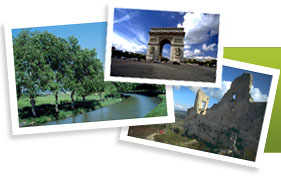The Ramparts
The 13th century city walls surrounding the Old Town are the best - preserved fortifications in the north of France. Built by the Count of Boulogne, Philipe Hurepel, on the site of an ancient Roman fort, the Ramparts are made up of seventeen turrets and four gates , which have changed very little over the years, and surround the Cathedral, the château, the 17th century watchtower and the cobbled streets of the Old Town. From the gates, visitors can access the ramparts from where they can enjoy fantastic views over the lower town and the surrounding countryside.
The Château and Musée du Château
The medieval castle and its moat was built at the same time as the Ramparts, in the 13th century, by the Count of Boulogne and was unique in that it was the first castle to be built without a keep in the history of military architecture. Over the years it has been used for a variety of purposes - fortress, barracks and a prison – and nowadays visitors can wander through the vaults and underground passages taking in the chapel, the baronial hall, and the gothic Salle Barbière (armoury). Housed in the Château is an impressive museum, the Musée du Château, which was created in 1825 and includes some wonderful exhibitions, some of which are unique in Europe. These include the largest collection of Greek vases after the Louvre in Paris, the largest collection of Inuit masks in the whole of Europe, Renaissance coins, Egyptian antiquities, Mediaeval pieces and fine art by masters of the 19th century. Another highlight is the display of the Roman foundations of Bononia Antiqua, the Roman settlement at Boulogne, in the new underground complex.
Basilique Notre Dame (Cathedral of Notre Dame)
The present Cathedral was built in the early 19th century on the site of the old Mediaeval church which was destroyed after the Revolution, and was inspired by St Paul’s Cathedral, St Peter’s in Rome, the Panethéon and Les Invalides in Paris. Its huge dome is visible throughout the city and reaches a height of 101m. Of particular interest is the High Alter of the Princess of Torlonia, decorated with 19th century Italian mosaic. The Cathedral also has the second largest crypt in France, which contains various gold and silver religious artefacts, inlcuding the Reliquary of the Holy Blood.
The Hôtel du Ville (Town Hall) & Le Belfroi (Belfry)
The Town Hall was originally built in 1735 during the reign of Louis XV, although it has been renovated over the years. It is the only building in the Old Town made of brick and stone and beneath the roof sit the sculpted emblems of the town, the swan and the three massive heraldic balls; these have been part of Boulogne’s coat of arms since the 11th century. The Belfry, attached to the Town Hall, is Boulogne’s oldest building dating from the 12th century and was originally the keep of the old mediaeval castle before becoming a belfry in the 13th century. Visitors can enjoy breathtaking views over the port, the town and the sea.
Maison de la Beurière
This tiny museum is set inside an authentic fisherman’scottage, built in 1870, in the former seamen's district of Boulogne-sur-Mer and shows how fishermen and their families lived at the beginning of the 20th century with authentic displays of furniture, clothes and objects from the time.
Colonne de la Grande Armée
The tallest column in France, the Colonne de la Grande Armée, topped with a statue of Napoleon, marks the site of the Camp of Boulogne where between 1803 and 1805 he planned his invasion of England. Here, in 1804, he also awarded the first Legions of Honour. The column was erected in 1841 and is made of Boulogne marble.
Calvaire des Marins (Sailors’ Cavalry)
Built to resemble the hull of a boat, the Calvaire des Marins is a sanctuary dedicated to the memory of sailors lost at sea. The poignant chapel is decorated with commemorative plaques and coloured buoys; coloured for the boats still at sea and black and white for those that never returned. Visitors can also enjoy views of the port, the sea and, on a clear day, across to England.
Nausicaä
The National Sea Discovery Centre of Nausicaa allows visitors to learn all about the seas and oceans of the world in a hands-on experience combining education and entertainment. The 36 aquariums contain 32,000 living creatures, including sharks, multicoloured fish and sea-lions and there is even a huge Touch Tank full of skate, turbot, cod and dogfish which is open-topped allowing visitors to stroke its inhabitants. With a variety of permanent and temporary exhibitions, the centre is trying to educate visitors in the importance of maintaining marine life. The current ‘Stormy Weather on our Planet” exhibition aims to educate people about ecology and the effect of dramatic meteorological disturbances such as drought, floods and storms and takes them on a tour around the world so they can understand the main causes of global warming and what they can do in their daily lifestyle to help. The tour ends with a gripping film in 3D about sea management and the need for biodiversity. www.nausicaa.fr


